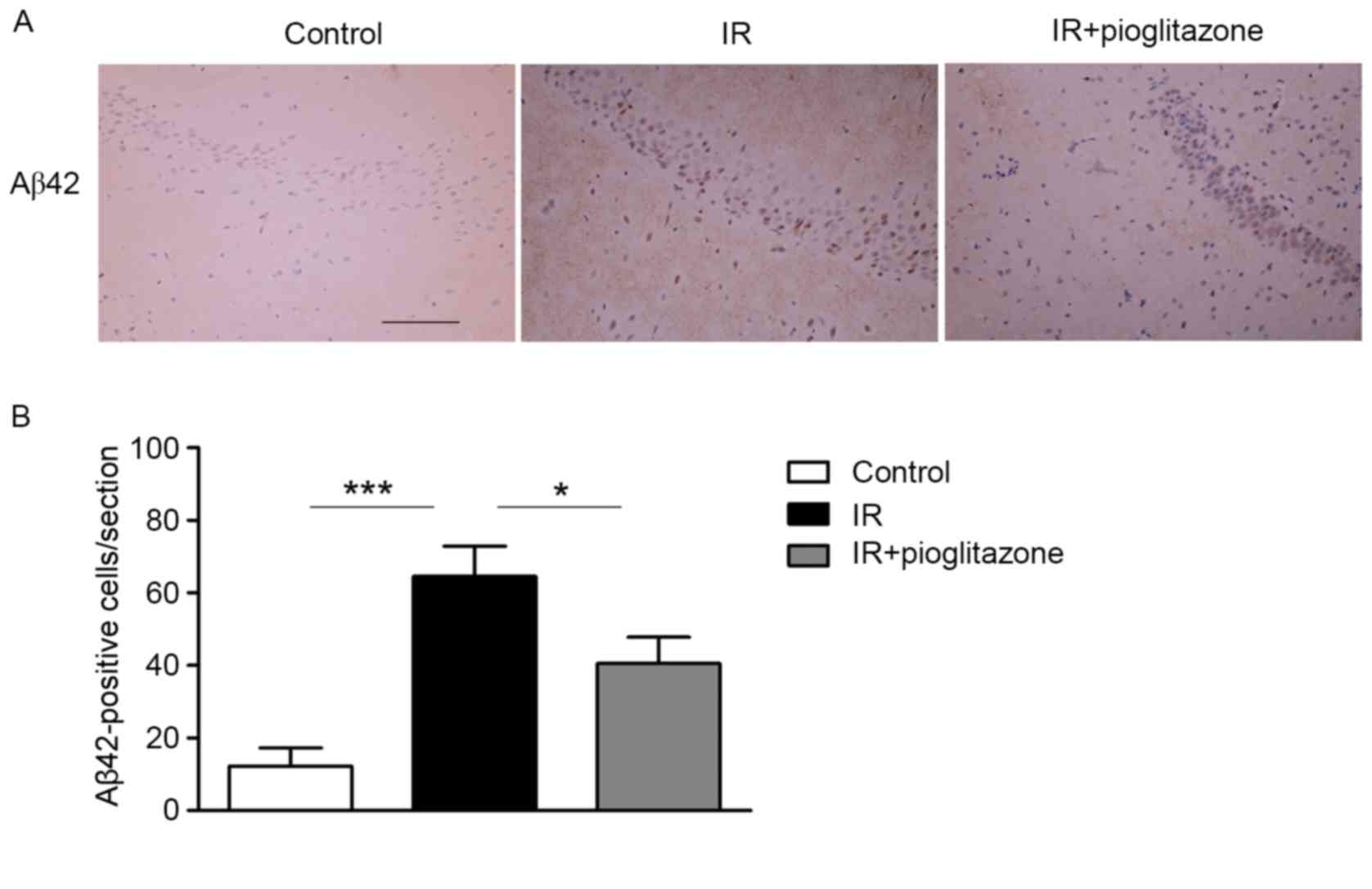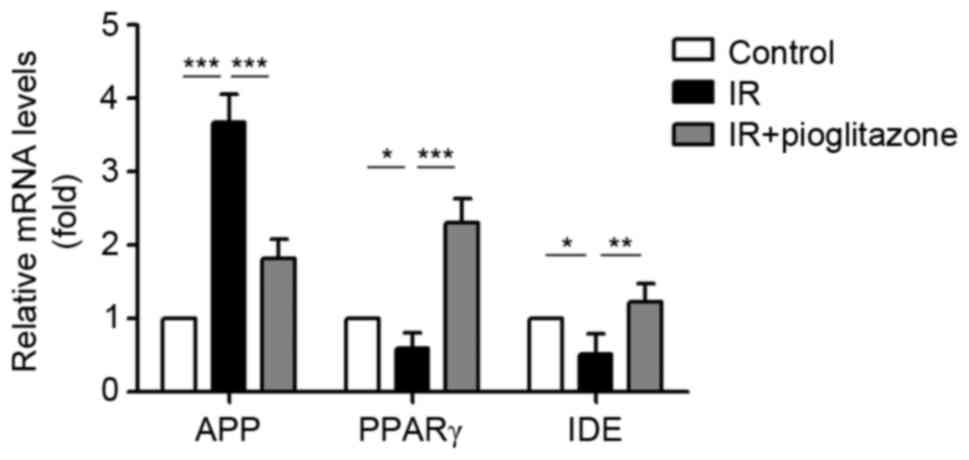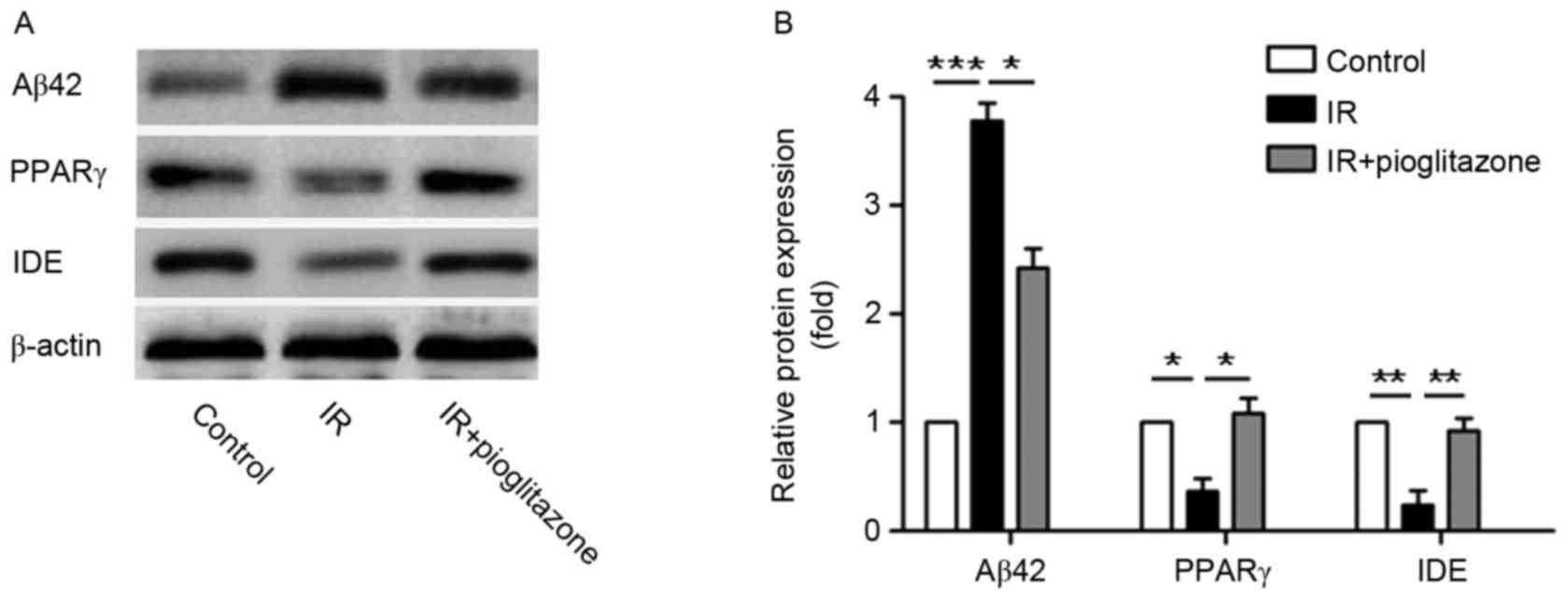Introduction
Alzheimer's disease (AD) is a progressive,
degenerative and irreversible neurological disorder that is
characterized by the formation of amyloid β (Aβ) plaques,
neurofibrillary tangles, amyloidal angiopathy and loss of neurons
and synapses (1). Accumulating
evidence indicates that obesity in middle age increases the risk
for AD and there is an association between AD and glucose
metabolism disorder (2). A number
of epidemiological studies have also demonstrated that type 2
diabetes mellitus (T2DM) appeared to be a significant risk factor
for AD (3,4). In patients with late-onset diabetes,
the incidence of AD was observed to be two times higher compared
with elderly patients without diabetes. Although the mechanisms
leading to AD are numerous and complex, the most common factor
among patients diagnosed with AD was reported to be insulin
resistance (IR) (5). Another study
hypothesized that peripheral IR may be able to induce nervous
system damage and cognitive impairment in patients (6).
IR is the decreased sensitivity of target organs to
insulin and is associated with metabolic defects and
hyperinsulinemia. Notably, continuous hyperinsulinemia may impair
the function of the blood-brain barrier and abrogate insulin
activity (7). One study
demonstrated that long-term neuronal exposure to a high-level
insulin environment led to neuronal degeneration and caused
irreversible cognitive dysfunction (8). In addition, long-term IR in the
peripheral tissues promoted IR in the brain by suppressing insulin
uptake and accelerating the accumulation of Aβ isoform 42 (Aβ42)
accumulation in the brain (9).
Signaling pathways associated with IR and Aβ accumulation in the
brain are complex. Insulin binding leads to autophosphorylation of
the insulin receptors, which initiates several signaling cascades
such as the phosphatidylinositol 3-kinase (PI3K) /protein kinase B
(AKT) phosphorylation of glycogen synthase kinase 3 (GSK3)
(10). GSK3α may promote the
generation of Aβ by modulating the cleavage of the amyloid
precursor protein (APP) at the γ-secretase site, a site that may
determine Aβ amyloidogenicity (11). A previous study demonstrated that
abolishing neuronal insulin signaling in neuron-specific insulin
receptor-knockout mice led to τ protein hyperphosphorylation and
activity, one of the hallmarks of AD, which was partly due to
alteration of AKT and GSK3 phosphorylation (12).
The insulin sensitizer pioglitazone is an agonist of
peroxisome proliferator-activated receptor γ (PPARγ). A previous
study indicated that pioglitazone improved learning ability and
attenuated Aβ deposition and t pathology in AD model mice (13). Treatment with pioglitazone may also
enhance cognition in patients with diabetes and AD, and decrease
fasting plasma insulin levels, indicating enhanced insulin
sensitivity (14). Notably, a
randomized pilot clinical trial suggested that pioglitazone was a
well-tolerated treatment in patients with AD (15). No serious or unanticipated adverse
events or clinical laboratory changes attributable to pioglitazone
were observed over long-term exposure in non-diabetic patients with
AD (16). Although pioglitazone
provided a potential benefit and therapeutic method for the
treatment of AD, particularly in patients with comorbid diabetes,
details of the functional mechanisms remain unclear.
In conclusion, results from the present study
indicated that pioglitazone may improve both peripheral and brain
insulin sensitivity in diet-induced IR model rats. Pioglitazone
reduced Aβ42 deposition associated with AKT/GSK3β activation by
increasing the levels of insulin-degrading enzyme (IDE) and PPARγ
expression. These data provide additional support and emphasize the
potential benefit of pioglitazone in managing glucose metabolism
and ameliorating Aβ42 accumulation in patients with AD.
Materials and methods
Animals and treatment
Healthy male Wistar rats (age, 10–12 weeks; 180–220
g, n=40) were purchased from the Experimental Animal Center of
Tongji Medical College (Huazhong University of Science and
Technology, Wuhan, China). All animals were treated in accordance
with the international ethical guidelines and the National
Institutes of Health Guide concerning the Care and Use of
Laboratory Animals. All of the protocols were approved by the
Institutional Ethics Committee of Huazhong University of Science
and Technology. They were provided with food and water ad libitum,
and kept under controlled temperature (22±2°C), humidity (55±5%)
and 12 h light/dark cycle. All animal experiments were performed in
compliance with the National Institutes of Health Guide for the
Care and Use of Laboratory Animals. Rats were randomly divided into
two groups: An IR model group (n=30) and a control group (n=10).
The control group was fed on a standard diet and IR model rats were
fed a high glucose, high fat and high protein diet (HD; calorie
percentage: 58.8% fat, 26.0% carbohydrate and 15.2% protein) from
the age of 10–12 weeks and were maintained on the HD diet for ≥12
weeks. HD-induced IR model rats were detected by homeostasis model
assessment-insulin resistance (HOMA-IR) using the formula:
HOMA-IR=fasting insulin (mIU/l) × fasting blood glucose (mM)/22.5
(13). Body weight and whole blood
glucose were measured prior to starting the defined diet, and
measurements were made once per week thereafter. Rats that did not
develop IR were excluded from the study, and the final number of IR
model rats used in the present study was 24.
All rats with HD-induced IR were randomly divided
into three subgroups; n=8 per group: i) The untreated IR model
group (n=8); ii) the IR + pioglitazone group, to which pioglitazone
(20 mg/kg; Merck KGaA, Darmstadt, Germany) was administered
intragastrically; and iii) the IR + pioglitazone + GW9662 group,
which received pioglitazone (20 mg/kg; intragastric administration)
and an intraperitoneal injection of the PPARγ inhibitor GW9662 (1
mg/kg; Sigma-Aldrich; Merck KGaA, Darmstadt, Germany). Pioglitazone
and GW9662 were dissolved in saline, and the treatments were
administered daily for 4 weeks.
Cerebrospinal fluid (CSF)
collection
Rats were anesthetized with 20% ethyl carbamate
(urethane; Sigma-Aldrich; Merck KGaA), and 20 µl CSF was collected
from the cisterna magna of each rat and stored in Eppendorf vials
containing Pefabloc SC (1.0 mM; Pentapharm Ltd., Aesch,
Switzerland) at −80°C.
Glucose and insulin measurement
Blood was collected from the tail vein of each rat
with a metal needle and blood glucose levels were measured using
the glucose oxidation method and a OneTouch UltraLink Blood Glucose
Meter (LifeScan, Inc., Milpitas, CA, USA). At the end of the
experiment the rats were decapitated for arterial blood. After
centrifugation at 12,000 × g for 10 min at 4°C, the plasma was
collected. Plasma and CSF insulin were determined using a rat
insulin kit by sandwich enzyme-linked immunosorbent assay (ELISA;
Mercodia AB, Uppsala, Sweden), according to the manufacturer's
protocol. All the experiments were repeated three times.
Tissue preparation
Rats were decapitated following anesthesia with 20%
ethyl carbamate (urethane) (Tianjin Kemiou Chemical Reagent Co.,
Ltd, Tianjin, China) and the hippocampus was rapidly dissected from
the hemisphere on an ice-cold board. The right hippocampus was
fixed in 4% paraformaldehyde (Sigma-Aldrich) at 4°C overnight and
embedded in paraffin for immunohistochemical analysis. The left
hippocampus was stored at −80°C for further analysis by western
blotting and reverse transcription-quantitative polymerase chain
reaction (RT-qPCR).
Immunohistochemistry
Following removal of paraffin, coronal brain
sections (4 µm) were sequentially treated with 0.25% Triton-X 100
in Tris-buffered saline (TBS; 50 mM Tris-HCl, 0.9% NaCl, pH 7.6)
for 10 min, blocked with 5% BSA (Sigma-Aldrich; Merck KGaA) at room
temperate for 60 min and incubated with primary anti-Aβ42 antibody
(rabbit anti-rat; 1:500; ab32136; Abcam, Cambridge, MA, USA) at
room temperature for 2 h. Following primary antibody incubation,
sections were washed with TBS for 10 min, blocked with 5% normal
goat serum (C0265; Beyotime, Nanjing, China) in TBS for 15 min,
incubated with biotin-conjugated secondary antibody (mouse
anti-rabbit; 1:500; sc-2491; Santa Cruz Biotechnology, Inc., Santa
Cruz, CA, USA) in TBS plus 0.8% normal goat serum for 1 h, washed
with TBS for 10 min and visualized with 3,3′-diaminobenzidine
(Sigma-Aldrich; Merck KGaA) using the Histostain-SP IHC kit (Zymed;
Thermo Fisher Scientific, Inc., Waltham, MA, USA). Sections (five
per experimental group) were evaluated under a Nikon Eclipse Ti-S
microscope (Nikon Corporation, Tokyo, Japan).
RT-qPCR
Total RNA was extracted from left hippocampus
tissues using TRIzol reagent (Invitrogen; Thermo Fisher Scientific,
Inc.), according to the manufacturer's protocol. Equal amounts of
RNA (1 µg) were used to synthesize cDNA using the Superscript
First-Strand Synthesis kit (Thermo Fisher Scientific, Inc.,
Waltham, MA, USA), according to the manufacturer's protocol.
Synthesized cDNAs were amplified using SYBR Green Supermix (Bio-Rad
Laboratories, Inc., Hercules, CA, USA) and a StepOne Real-Time PCR
System (Applied Biosystems; Thermo Fisher Scientific, Inc.).
β-actin was used as an internal standard to control the variability
in amplification. The data were analyzed by the 2−ΔΔCq
method (15). The following
primers were used: PPARγ, forward 5′-ACCCATCAGGGACCAAAAC-3′ and
reverse 5′-GGCATCGCTTACAAACTCACC-3′; IDE, forward
5′-TTTCCTGAGCACCCTTTCCA-3′ and reverse
5′-CAGATGACCGAGATAATGACCG-3′; APP, forward
5′-ACCCATCAGGGACCAAAACC-3′ and reverse 5′-GGCATCGCTTACAAACTCACC-3′;
β-actin, forward 5′-TCATGAGGTAGTCAGTCAGG-3′ and reverse
5′-CTTCTACAATGAGCTGCGTG-3′. The amplification conditions were: 5
min at 94°C; 35 cycles of 45 sec at 94°C, 1 min at 56°C and 1 min
at 72°C; followed by 10 min at 72°C. All the experiments were
repeated three times.
Western blotting
Total protein was extracted from the left
hippocampus, washed once with ice-cold PBS, and lysed with a lysis
buffer (50 mM Tris HCl pH 7.5, 150 mM NaCl, 1 mM EDTA, 0.1% SDS,
0.2% deoxycholic acid and 1:100 protease inhibitor cocktail).
Lysates were centrifuged for 10 min at 12,000 × g at 4°C and
supernatants were analyzed for protein concentration using a BCA
Protein Assay kit (Thermo Fisher Scientific, Inc.). Proteins were
denatured at 95°C (10 min, 30 µg), separated by electrophoresis
(SDS-PAGE, 4% stacking gel and 10% separating gel) and transferred
onto nitrocellulose membranes (Sigma-Aldrich; Merck KGaA).
Membranes were washed in TBS with 0.05% Tween-20 (TBST) prior to
blocking with 5% skimmed milk at 37°C for 1 h, followed by
overnight incubation at 37°C with polyclonal rabbit antibodies
anti-Aβ42 (1:5,000; ab32136), anti-IDE (1:500; ab32216),
anti-phosphorylated (p)-AKT Thr308 (1:500; ab194875), total AKT
(1:500; ab79360; all from Abcam), PPARγ antibody (1:1,000;
sc-7196), β-actin (1:1,000; sc-7210; both from Santa Cruz
Biotechnology, Inc.), total GSK3β (1:1,000; 5676) or p-GSK3β Ser9
(1:1,000; 9327; both from Cell Signaling Technology, Inc., Danvers,
MA, USA), followed by 1 h incubation at 37°C with secondary
antibodies (horseradish peroxidase conjugated goat anti-rabbit;
ab98485; 1:10,000; Abcam). Immunoreactive bands were detected by
enhanced chemiluminescence peroxidase-catalyzed peroxidation of
luminol in the system and were analyzed using Quantity One Software
version 4.6.3 (Bio-Rad Laboratories, Inc.). To analyze the results
across different experiments (n≥3), optical density levels were
normalized to β-actin in the respective western blots.
Statistical analysis
Data were analyzed by one-way analysis of variance,
followed by post hoc tests (Newman-Keuls) or Student's t-test using
Prism 5 (version 5; GraphPad Software, Inc., La Jolla, CA, USA).
Results are expressed as the mean ± standard deviation, and
P<0.05 was considered to indicate a statistically significant
difference.
Results
Pioglitazone improves insulin
sensitivity in the peripheral and the central nervous system of
HD-induced IR model rats
IR model rats were established by feeding a HD diet
for 12 weeks; HOMA-IR assessment identified that 24 out of 30 rats
(80%) developed IR (data not shown). Rats fed a HD diet gained 20%
more weight and had significantly higher HOMA-IR compared with
control rats (Fig. 1A and B,
respectively). Plasma insulin levels were also significantly higher
in IR model rats compared with rats in the control group (Fig. 1C); however, plasma glucose levels
were similar between the two groups (Fig. 1D). These results confirmed the
successful establishment of IR model rats. By contrast, there was a
significant decrease in the levels of insulin in the CSF in IR
model rats compared with control rats (Fig. 1E), suggesting decreased insulin
signaling in the brain of IR rats. Following treatment with
pioglitazone (Fig. 1), HOMA-IR and
plasma insulin levels were significantly reduced compared with rats
in the untreated IR group, however the weight and the levels of
plasma glucose and CSF insulin were not significantly changed.
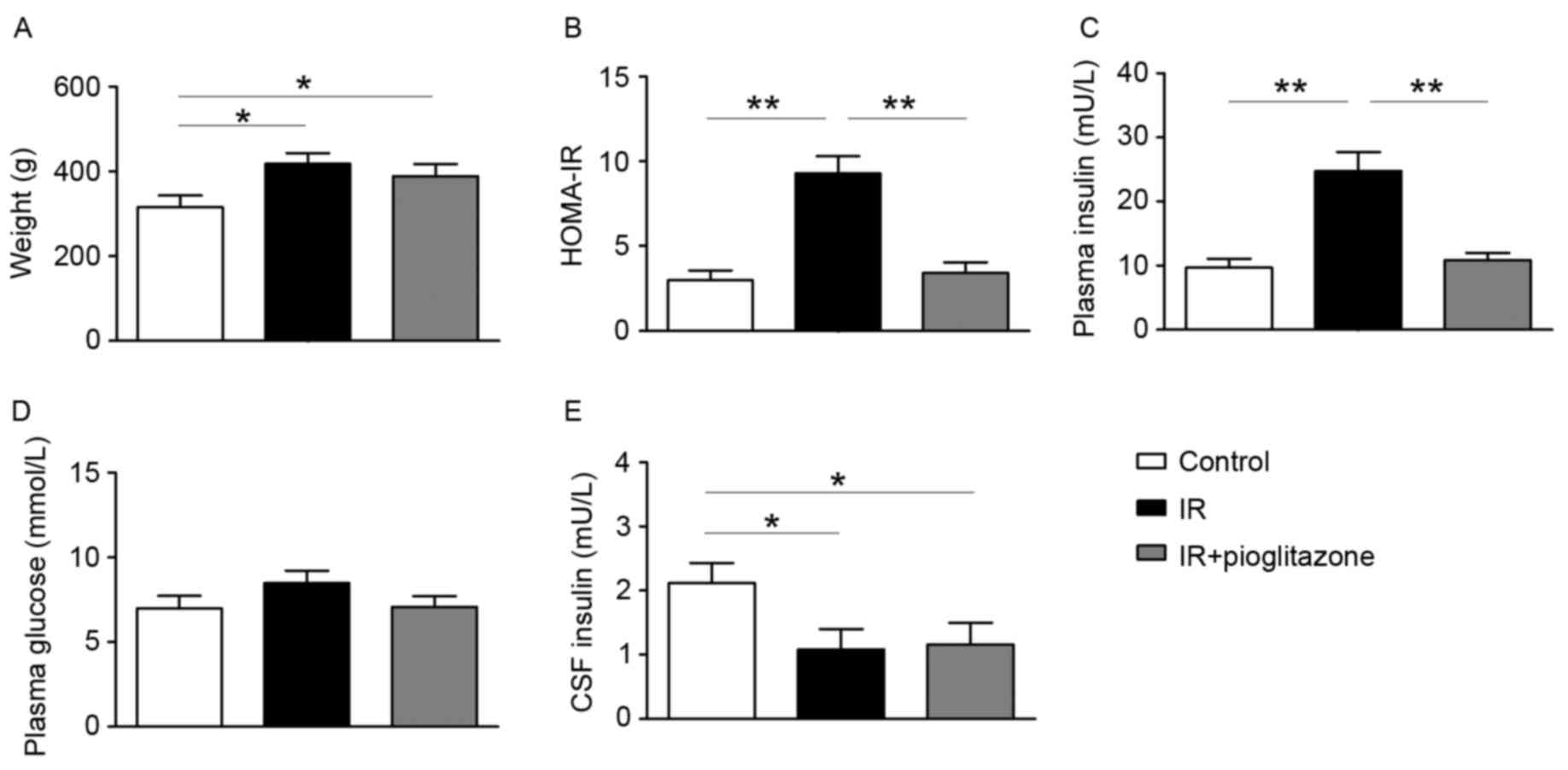 | Figure 1.Pioglitazone treatment improves
insulin sensitivity in HD-induced IR rats. Rats were assessed
following 16 weeks (12 weeks to establish the IR model plus 4 weeks
treatment/HD-diet) on a normal or HD diet for different indices of
HD-induced IR, including: (A) Body weight, (B) HOMA-IR, (C) plasma
insulin, (D) plasma glucose and (E) CSF insulin. Data are presented
as the mean ± standard deviation. Control group, n=10; IR model rat
groups, n=8/group. *P<0.05 and **P<0.01. CSF, cerebrospinal
fluid; HD, high glucose, high fat and high protein diet; HOMA-IR,
homeostasis model assessment-insulin resistance; IR, insulin
resistance. |
Pioglitazone reduces Aβ42 accumulation
in the hippocampus in IR model rats
To investigate whether pioglitazone is able to
inhibit Aβ42 deposition in rat brains, the hippocampus of rats from
each group were stained with a polyclonal antibody against Aβ42.
Only background staining was observed in control rats, whereas Aβ42
immunostaining was stronger and detected in more neurons throughout
the hippocampus in IR rats (Fig.
2). IR model rats treated with pioglitazone for 4 weeks
exhibited significantly reduced levels of Aβ42 accumulation,
particularly in the dentate gyrus of the hippocampus, compared with
the untreated IR group (Fig. 2).
These observations suggested that pioglitazone may normalize levels
of Aβ42 accumulation/concentration in the brain (reduce the levels
of Aβ42 accumulation in the brains of IR rats).
Pioglitazone increases the expression
levels of IDE and PPARγ following decreased Aβ42 deposition
The levels of expression of IDE and PPARγ mRNA and
protein were decreased in the hippocampus of IR model rats compared
with rats in the control group (Figs.
3 and 4), whereas the
expression level of APP mRNA was higher in IR rats compared with
the control (Fig. 3). The results
indicated that impaired insulin signaling in the brain was followed
by a decrease in the expression of IDE and PPARγ, and led to a
subsequent increase in Aβ42 protein expression in IR rats (Fig. 4). Following pioglitazone treatment
in IR rats, the mRNA and protein expression levels of IDE and PPARγ
increased (Figs. 3 and 4), and the levels of APP mRNA and Aβ42
protein decreased compared with untreated IR rats (Figs. 3 and 4, respectively). These data suggested
that IDE and PPARγ may be involved in the inhibitory effect of
pioglitazone on Aβ42 accumulation.
Pioglitazone ameliorates Aβ42
accumulation via the AKT/GSK3β-signaling pathway
To investigate the molecular mechanisms by which
pioglitazone reduces Aβ42 accumulation in IR model rats, the
protein expression levels of p-AKT and p-GSK3β, which are two
important protein kinases in the insulin-signaling pathway, were
examined (Fig. 5). There was a
marked increase in the phosphorylation of both AKT at Thr308 and
GSK3β at Ser9 in the hippocampus of IR rats treated with
pioglitazone compared with rats in the untreated IR group, whereas
the total levels of expression of these two kinases (AKT and GSK3β
expression between the control and IR groups) were unchanged.
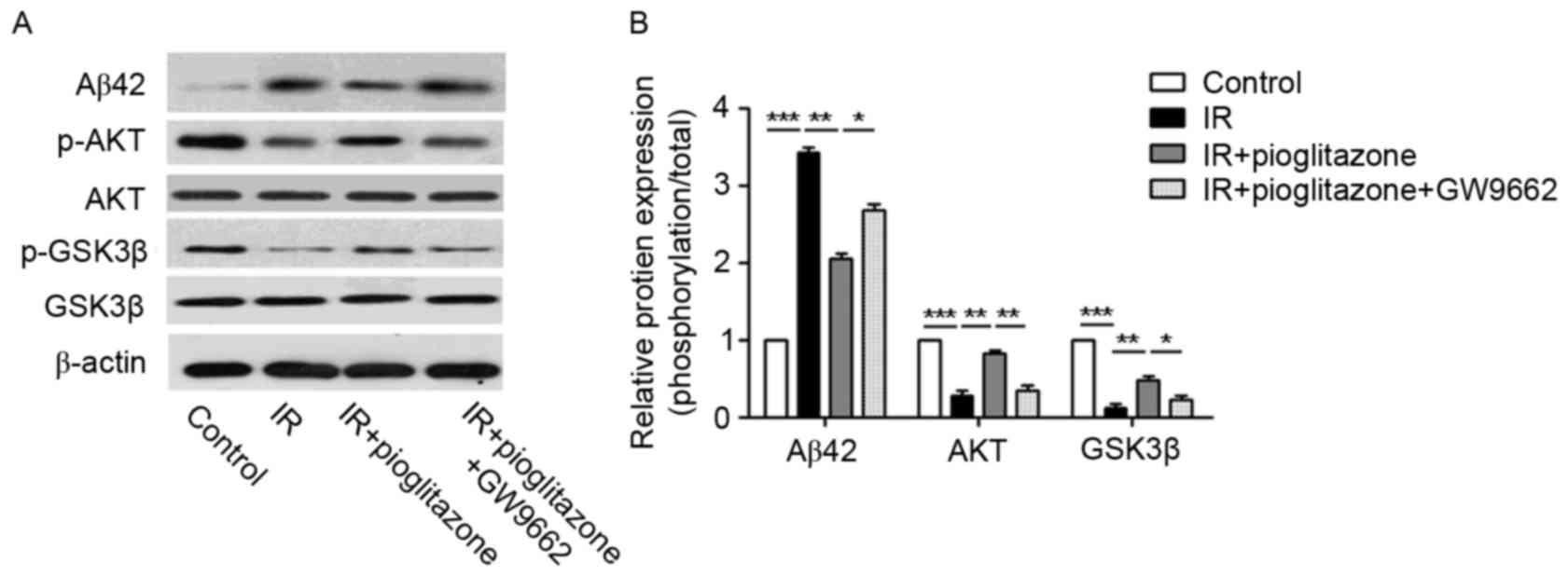 | Figure 5.GW9662 reverses inhibiting effect of
Pioglitazone on Aβ42 deposition in IR model rats via AKT/GSK3β
signaling pathway. (A) Western blot analysis of the protein
expression of Aβ42 and components of the AKT/GSK3β signaling
pathway in the different experimental rat groups. (B) Densitometric
analysis of the bands in (A), all normalized to β-actin. Control
group, n=10; IR model rat groups, n=8/group. Data are presented as
the mean ± standard deviation. *P<0.05, **P<0.01 and
***P<0.001. Aβ42, amyloid β, isoform 42; p-, phosphorylated;
AKT, protein kinase B; GSK3β, glycogen synthase kinase 3β; GW9662,
peroxisome proliferator-activated receptor γ inhibitor; IR, insulin
resistance. |
As an agonist of PPARγ, pioglitazone treatment was
demonstrated to result in the increased expression of IDE and
PPARγ, and the decreased accumulation of Aβ42 (Figs. 3 and 4). By contrast, IR + pioglitazone rats
co-treated with the PPARγ antagonist GW9662 exhibited a decrease in
the levels of AKT and GSK3β phosphorylation and Aβ42 deposition
compared with IR rats treated with pioglitazone alone (Fig. 5). These data suggest that PPARγ may
serve a crucial role in the pioglitazone-inhibited expression of
Aβ42.
Discussion
A number of studies have indicated that the binding
and activation of PPARγ by the TZD drug pioglitazone may be able to
alleviate synaptic dysfunctions and cognitive impairment in AD
mouse models and patients with AD associated with diabetes
(17–19). Results from the present study
demonstrated that pioglitazone may help improve both peripheral and
brain insulin sensitivity in rats with HD-induced IR. Pioglitazone
ameliorated Aβ42 deposition associated with AKT/GSK3β activation by
increasing the expression of IDE and PPARγ.
Preclinical and clinical evidence suggest a
pathophysiological connection between AD and diabetes. Alterations
in metabolism, inflammation and IR are characteristic features of
both diseases (19,20). Increased Aβ42/Aβ40 and total τ
expression were demonstrated to be exacerbated by IR, and
hyperphosphorylated-τ and AD-amyloidosis models exhibited IR
(21). Insulin reduced the
generation and aggregation of Aβ, while IDE degraded Aβ, suggesting
that IR may serve a major role in the progress of AD (22). The link between AD and IR may be
associated with the role of insulin in brain metabolism and
plasticity. Insulin passes through the blood-brain barrier and
regulates glucose metabolism, this process affects amyloid (Aβ42),
neuronal survival and neural network plasticity (23). A previous study also indicated
elevated Aβ levels induced the removal of insulin receptors on the
cell surface, thus enhancing IR (24). In addition, inflammatory responses,
which were present in patients with obesity and T2DM, were
indicated to be closely associated with the development of IR in
both peripheral and central tissues (25). Therefore, abnormal brain IR may be
an important and early pathological feature that significantly
increases the risk of AD.
IDE is a highly conserved Zn2+-dependent
endopeptidase that degrades insulin and regulates peripheral
insulin levels (26), and is one
of the key enzymes involved in Aβ degradation in the brain
(27). Genetic variants in the
haplotype block that span the IDE gene have been associated with
higher levels of plasma Aβ42 and an increased risk of AD (28). Compared with peripheral insulin
receptors, brain insulin receptors are not downregulated by high
insulin levels, suggesting that IDE may act as an effector molecule
that inhibits insulin signaling when insulin levels are high
(29). In the brain of AD
patients, insulin levels were abnormally low, decreasing the amount
of insulin available to compete with Aβ42 for IDE (30); this is in contrast to the
hypothesis that Aβ42 was degraded more effectively and the level of
Aβ42 decreased. However, results from the present study
demonstrated an increased Aβ42 with lower IDE and PPARγ expression
in IR rat brains. Consistent with this, a previous report
demonstrated that IR induced by a high-fat diet was associated with
reduced IDE levels and increased amyloidosis in an AD animal model
(25). In the present study,
treatment with pioglitazone led to an increase in the expression of
IDE and PPARγ, and a reduction of Aβ42 accumulation in IR model
rats. These results suggested that pioglitazone decreased brain
Aβ42 deposition in rats with IR, possibly by activating IDE and
PPARγ expression.
A previous study demonstrated that pioglitazone was
a potential therapeutic method for the treatment of AD, especially
in an animal model of AD comorbid diabetes (31). However, the mechanisms underlying
these neuroprotective effects remain to be determined. One recent
study involving fructose-induced IR model rats reported an
improvement in cognitive functions owing to an increase in insulin
sensitivity and antioxidant defense system, which corresponded with
a decrease in IDE activity (32).
An additional previous study demonstrated that pioglitazone-treated
AD model mice exhibited a number of beneficial effects, including
improvements in learning, lowered serum cholesterol, fewer Aβ and τ
deposits in the hippocampus, and enhanced short- and long-term
plasticity (33). In addition,
pioglitazone was observed to suppress the hyperactivation of
cyclin-dependent kinase 5 in the hippocampus of APP/presenilin 1
mutant mouse by reducing the protein expression levels of p35,
which regulated Aβ-induced dendritic spine loss in the brain
(31). An association has been
identified between the activation of the AKT/GSK3β-signaling
pathway and Aβ-induced memory impairments (34). Dalesconol B (TL-2), a potent
immunosuppressive agent with an unusual carbon skeleton, induced
the nuclear translocation of β-catenin and enhanced its
transcriptional activity through the AKT/GSK3β pathway to promote
neuronal survival, which attenuates β-amyloid induced neuronal
apoptosis (35). Melatonin was
also demonstrated to exhibit neuroprotective effects against
Aβ42-induced neurotoxicity through decreasing memory impairment,
synaptic disorder, τ hyperphosphorylation and neurodegeneration via
PI3K/AKT/GSK3β signaling in the Aβ1–42-treated mouse
hippocampal cell lines (36).
Consistent with previous studies (31,32),
results from the present study also indicated that pioglitazone
ameliorated Aβ42 accumulation by regulating AKT/GSK3β signaling in
rats with HD-induced IR. However, additional studies are required
to determine if other mechanisms are involved or affected by
pioglitazone treatment.
In conclusion, results from the present study
indicated that pioglitazone may improve insulin sensitivity and
ameliorate Aβ42 deposition in the hippocampus of IR model rats and
is associated with activation of AKT/GSK3β signaling via increasing
the expression of IDE and PPARγ. These results provide supporting
evidence and emphasize a potential benefit of pioglitazone in the
management of glucose metabolism and the treatment of AD.
Acknowledgements
The present study was supported by a grant from the
National Natural Science Foundation of China (grant no.
81503426).
References
|
1
|
Musiek ES and Holtzman DM: Three
dimensions of the amyloid hypothesis: Time, space and ‘wingmen’.
Nat Neurosci. 18:800–806. 2015. View
Article : Google Scholar : PubMed/NCBI
|
|
2
|
Talbot K and Wang HY: The nature,
significance, and glucagon-like peptide-1 analog treatment of brain
insulin resistance in Alzheimer's disease. Alzheimers Dement. 10:(1
Suppl). S12–S25. 2014. View Article : Google Scholar : PubMed/NCBI
|
|
3
|
Tolppanen AM, Solomon A, Soininen H and
Kivipelto M: Midlife vascular risk factors and Alzheimer's disease:
Evidence from epidemiological studies. J Alzheimers Dis.
32:531–540. 2012.PubMed/NCBI
|
|
4
|
Toda N, Ayajiki K and Okamura T:
Obesity-induced cerebral hypoperfusion derived from endothelial
dysfunction: One of the risk factors for Alzheimer's disease. Curr
Alzheimer Res. 11:733–744. 2014. View Article : Google Scholar : PubMed/NCBI
|
|
5
|
Craft S: Insulin resistance syndrome and
Alzheimer disease: Pathophysiologic mechanisms and therapeutic
implications. Alzheimer Dis Assoc Disord. 20:298–301. 2006.
View Article : Google Scholar : PubMed/NCBI
|
|
6
|
Wang F, Song YF, Yin J, Liu ZH, Mo XD,
Wang DG, Gao LP and Jing YH: Spatial memory impairment is
associated with hippocampal insulin signals in ovariectomized rats.
PLoS One. 9:e1044502014. View Article : Google Scholar : PubMed/NCBI
|
|
7
|
Tucsek Z, Toth P, Sosnowska D, Gautam T,
Mitschelen M, Koller A, Szalai G, Sonntag WE, Ungvari Z and Csiszar
A: Obesity in aging exacerbates blood-brain barrier disruption,
neuroinflammation, and oxidative stress in the mouse hippocampus:
Effects on expression of genes involved in beta-amyloid generation
and Alzheimer's disease. J Gerontol A Biol Sci Med Sci.
69:1212–1226. 2014. View Article : Google Scholar : PubMed/NCBI
|
|
8
|
Grasso G, Mielczarek P, Niedziolka M and
Silberring J: Metabolism of cryptic peptides derived from
neuropeptide FF precursors: The involvement of insulin-degrading
enzyme. Int J Mol Sci. 15:16787–16799. 2014. View Article : Google Scholar : PubMed/NCBI
|
|
9
|
Park SA: A common pathogenic mechanism
linking type-2 diabetes and Alzheimer's disease: Evidence from
animal models. J Clin Neurol. 7:10–18. 2011. View Article : Google Scholar : PubMed/NCBI
|
|
10
|
Baker LD, Cross DJ, Minoshima S, Belongia
D, Watson GS and Craft S: Insulin resistance and Alzheimer-like
reductions in regional cerebral glucose metabolism for cognitively
normal adults with prediabetes or early type 2 diabetes. Arch
Neurol. 68:51–57. 2011. View Article : Google Scholar : PubMed/NCBI
|
|
11
|
Jolivalt CG, Lee CA, Beiswenger KK, Smith
JL, Orlov M, Torrance MA and Masliah E: Defective insulin signaling
pathway and increased glycogen synthase kinase-3 activity in the
brain of diabetic mice: Parallels with Alzheimer's disease and
correction by insulin. J Neurosci Res. 86:3265–3274. 2008.
View Article : Google Scholar : PubMed/NCBI
|
|
12
|
Schubert M, Gautam D, Surjo D, Ueki K,
Baudler S, Schubert D, Kondo T, Alber J, Galldiks N, Küstermann E,
et al: Role for neuronal insulin resistance in neurodegenerative
diseases. Proc Natl Acad Sci USA. 101:3100–3105. 2005. View Article : Google Scholar
|
|
13
|
Sato T, Hanyu H, Hirao K, Kanetaka H,
Sakurai H and Iwamoto T: Efficacy of PPAR-γ agonist pioglitazone in
mild Alzheimer disease. Neurobiol Aging. 32:1626–1633. 2011.
View Article : Google Scholar : PubMed/NCBI
|
|
14
|
Nicolakakis N, Aboulkassim T, Ongali B,
Lecrux C, Fernandes P, Rosa-Neto P, Tong XK and Hamel E: Complete
rescue of cerebrovascular function in aged Alzheimer's disease
transgenic mice by antioxidants and pioglitazone, a peroxisome
proliferator-activated receptor γ agonist. J Neurosci.
28:9287–9996. 2008. View Article : Google Scholar : PubMed/NCBI
|
|
15
|
Geldmacher DS, Fritsch T, McClendon MJ and
Landreth G: A randomized pilot clinical trial of the safety of
pioglitazone in treatment of patients with Alzheimer's disease.
Arch Neuro. 68:45–50. 2011. View Article : Google Scholar
|
|
16
|
Wang Z, Yan Z, Zhang B, Rao Z, Zhang Y,
Liu J, Yu L, Zhao Y, Yang B, Wu T and Gao J: Identification of a
5-gene signature for clinical and prognostic prediction in gastric
cancer patients upon microarray data. Med Oncol. 30:6782013.
View Article : Google Scholar : PubMed/NCBI
|
|
17
|
Pérez MJ and Quintanilla RA: Therapeutic
actions of the thiazolidinediones in Alzheimer's disease. PPAR Res.
2015:9572482015. View Article : Google Scholar : PubMed/NCBI
|
|
18
|
Craft S: Insulin resistance syndrome and
Alzheimer's disease: Age- and obesity-related effects on memory,
amyloid, and inflammation. Neurobiol Aging. 26:65–69. 2005.
View Article : Google Scholar : PubMed/NCBI
|
|
19
|
Sato N, Takeda S, Uchio-Yamada K, Ueda H,
Fujisawa T, Rakugi H and Morishita R: Role of insulin signaling in
the interaction between Alzheimer disease and diabetes mellitus: A
missing link to therapeutic potential. Curr Aging Sci. 4:118–127.
2011. View Article : Google Scholar : PubMed/NCBI
|
|
20
|
Najem D, Bamji-Mirza M, Chang N, Liu QY
and Zhang W: Insulin resistance, neuroinflammation, and Alzheimer's
disease. Rev Neurosci. 25:509–525. 2014. View Article : Google Scholar : PubMed/NCBI
|
|
21
|
Mayeux R, Honig LS, Tang MX, Manly J,
Stern Y, Schupf N and Mehta PD: Plasma A[beta]40 and A[beta]42 and
Alzheimer's disease: Relation to age, mortality, and risk.
Neurology. 61:1185–1190. 2003. View Article : Google Scholar : PubMed/NCBI
|
|
22
|
Qiu WQ and Folstein MF: Insulin,
insulin-degrading enzyme and amyloid-beta peptide in Alzheimer's
disease: Review and hypothesis. Neurobiol Aging. 27:190–198. 2006.
View Article : Google Scholar : PubMed/NCBI
|
|
23
|
Neumann KF, Rojo L, Navarrete LP, Farías
G, Reyes P and Maccioni RB: Insulin resistance and Alzheimer's
disease: Molecular links & clinical implications. Curr
Alzheimer Res. 5:438–447. 2008. View Article : Google Scholar : PubMed/NCBI
|
|
24
|
Zhao WQ, De Felice FG, Fernandez S, Chen
H, Lambert MP, Quon MJ, Krafft GA and Klein WL: Amyloid beta
oligomers induce impairment of neuronal insulin receprors. Faseb J.
22:246–260. 2008. View Article : Google Scholar : PubMed/NCBI
|
|
25
|
Ho L, Qin W, Pompl PN, Xiang Z, Wang J,
Zhao Z, Peng Y, Cambareri G, Rocher A, Mobbs CV, et al:
Diet-induced insulin resistance promotes amyloidosis in a
transgenic mouse model of Alzheimer's disease. FASEB J. 18:902–904.
2004.PubMed/NCBI
|
|
26
|
Fernández-Gamba A, Leal MC, Morelli L and
Castaño EM: Insulin-degrading enzyme structure-function
relationship and its possible roles in health and disease. Curr
Pharm Des. 15:3644–3655. 2009. View Article : Google Scholar : PubMed/NCBI
|
|
27
|
Farris W, Mansourian S, Chang Y, Lindsley
L, Eckman EA, Frosch MP, Eckman CB, Tanzi RE, Selkoe DJ and
Guenette S: Insulin-degrading enzyme regulates the levels of
insulin, amyloid beta-protein, and the beta-amyloid precursor
protein intracellular domain in vivo. Proc Natl Acad Sci USA.
100:4162–4167. 2003. View Article : Google Scholar : PubMed/NCBI
|
|
28
|
Bertram L, Blacker D, Mullin K, Keeney D,
Jones J, Basu S, Yhu S, McInnis MG, Go RC, Vekrellis K, et al:
Evidence for genetic linkage of Alzheimer's disease to chromosome
10q. Science. 290:2302–2303. 2000. View Article : Google Scholar : PubMed/NCBI
|
|
29
|
Zahniser NR, Goens MB, Hanaway PJ and
Vinych JV: Characterization and regulation of insulin receptors in
rat brain. J Neurochem. 42:1354–1362. 1984. View Article : Google Scholar : PubMed/NCBI
|
|
30
|
Cook DG, Leverenz JB, McMillan PJ, Kulstad
JJ, Ericksen S, Roth RA, Schellenberg GD, Jin LW, Kovacina KS and
Craft S: Reduced hippocampal insulin-degrading enzyme in late-onset
Alzheimer's disease is associated with the apolipoprotein E-epsilon
4 allele. Am J Pathol. 162:313–319. 2003. View Article : Google Scholar : PubMed/NCBI
|
|
31
|
Chen J, Li S, Sun W and Li J:
Anti-diabetes drug pioglitazone ameliorates synaptic defects in AD
transgenic mice by inhibiting cyclin-dependent kinase 5 activity.
PLoS One. 10:e01238642015. View Article : Google Scholar : PubMed/NCBI
|
|
32
|
Yin QQ, Pei JJ, Xu S, Luo DZ, Dong SQ, Sun
MH, You L, Sun ZJ and Liu XP: Pioglitazone improves cognitive
function via increasing insulin sensitivity and strengthening
antioxidant defense system in fructose-drinking insulin resistance
rats. PLoS One. 8:e593132013. View Article : Google Scholar : PubMed/NCBI
|
|
33
|
Searcy JL, Phelps JT, Pancani T, Kadish I,
Popovic J, Anderson KL, Beckett TL, Murphy MP, Chen KC, Blalock EM,
et al: Long-term pioglitazone treatment improves learning and
attenuates pathological markers in a mouse model of Alzheimer's
disease. J Alzheimers Dis. 30:943–961. 2012.PubMed/NCBI
|
|
34
|
Lee HK, Kumar P, Fu Q, Rosen KM and
Querfurth HW: The insulin/Akt signaling pathway is targeted by
intracellular beta-amyloid. Mol Biol Cell. 20:1533–1544. 2009.
View Article : Google Scholar : PubMed/NCBI
|
|
35
|
Zhu X, Wang S, Yu L, Yang H, Tan R, Yin K,
Jin J, Zhao H, Guan D and Xu Y: TL-2 attenuates β-amyloid induced
neuronal apoptosis through the AKT/GSK-3β/β-catenin pathway. Int J
Neuropsychopharmacol. 17:1511–1519. 2014. View Article : Google Scholar : PubMed/NCBI
|
|
36
|
Kwon KJ, Kim HJ, Shin CY and Han SH:
Melatonin potentiates the neuroprotective properties of resveratrol
against beta-amyloid-induced neurodegeneration by modulating
AMP-activated protein kinase pathways. J Clin Neurol. 6:127–137.
2010. View Article : Google Scholar : PubMed/NCBI
|
















